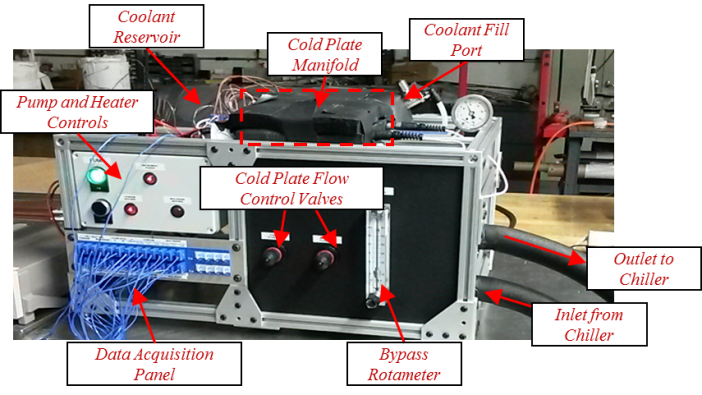Single-phase cold plates are commonly used to dissipate waste heat from electronics components. To accommodate the varying footprint and output power of electronics components available, cold plates are being developed with custom internal structures to maximize the efficiency of heat rejection from the electronics components. Cold plates with these custom internal structures require thermal and hydraulic performance evaluations to ensure they meet target operating conditions before being deployed in the end application. Advanced Cooling Technologies, Inc. developed the custom test apparatus, shown in Figure 1, for a customer that enables the thermal and hydraulic performance of multiple cold plate designs to be evaluated and compared under equivalent operating conditions in order to identify the optimum cold plate design.


This test apparatus was designed with an integrated data acquisition (DAQ) panel to read and record instrument responses from thermocouples and pressure transducers, easy connection to an external chiller, and a custom manifold that enabled cold plates of various internal geometries to be connected and removed from the test apparatus. The test apparatus was outfitted with resistance temperature detectors (RTDs) at the inlet and outlet ports and differential pressure transducers such that the temperature rise and pressure drop of the cold plate can be measured.
Cold plates to be tested are prepared with heat sources and outfitted with surface mount thermocouples and incorporated into the test apparatus. The heat sources are energized with an external power supply and once steady-state is achieved, the thermal resistance of the cold plate is calculated from Equation 1 where Rth is the thermal resistance of the cold plate, Ts is the surface temperature of the heat source, Tout is the outlet temperature of the cold plate, Tin is the inlet temperature of the cold plate, is the mass flow rate of coolant, and Cp is the specific heat capacity of the coolant.

For any given cold plate configuration, there is a pumping power required to remove a certain amount of heat. The coefficient of performance (COP) of a cold plate is a dimensionless number that provides a measure of the amount of pumping power required to remove a given amount of heat and provides an equivalent comparison for different cold plate configurations. Thus, in addition to the thermal resistance of the cold plate, the COP of the cold plates can be evaluated from Equation 2, where ΔP is the pressure drop of the cold plate and is the volumetric flow rate of coolant through the cold plate.

Thus, this single test apparatus, designed, developed, and fabricated by ACT, can provide a full thermal and hydraulic performance evaluation to enable the down selection of the optimal cold plate for a given set of operating conditions.
